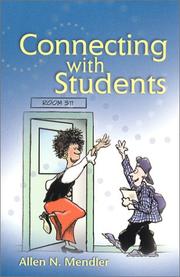| Listing 1 - 3 of 3 |
Sort by
|

ISBN: 1280930888 9786610930883 1416600833 087120911X 0871207311 9780871207319 9780871209115 9781416600831 9781280930881 0871205734 9780871205735 1416615989 9781416615989 Year: 2001 Publisher: Alexandria, VA Association for Supervision and Curriculum Development
Abstract | Keywords | Export | Availability | Bookmark
 Loading...
Loading...Choose an application
- Reference Manager
- EndNote
- RefWorks (Direct export to RefWorks)
How many teachers take the time to connect with students on a personal level? How do you find the time, anyway? Teachers who manage to transcend the normal student-teacher relationships can benefit everyone in school--particularly the "challenging" students--and, along the way, prevent school violence, support school safety, improve school climate, and promote learning. In a time of an increasingly rigid "zero tolerance" of the slightest hint of violence, which results in automatic suspension or expulsion, Allen N. Mendler calls for a more caring, flexible approach to school safety.Connecting with Students outlines dozens of positive strategies for bridging the gap between teacher and student through personal, academic, and social connections. Easily tailored to any learning environment, the activities and guidelines provide you with the tools you need in the classroom, from the "H & H" greeting to the "2 x 10" method and the "4H," "think-aloud," and "paradoxical" strategies. As both teachers and administrators alter their own attitudes and behavior, they learn to listen to students and accommodate their needs. The end result will be lasting relationships that can foster deeper understanding and growth for educators and students alike. In this book, you will discover ways to stay optimistic and persistent and see your students as having something to teach you.
Teacher-student relationships. --- Classroom management. --- School discipline --- School management and organization --- Teaching --- Pupil-teacher relationships --- Student and teacher --- Student-teacher relationships --- Students and teachers --- Teacher and student --- Teacher-pupil relationships --- Teachers and students --- Interpersonal relations
Book
ISBN: 1416625836 9781416625834 9781416625810 1416625844 9781416625841 Year: 2018 Publisher: Alexandria, Virginia
Abstract | Keywords | Export | Availability | Bookmark
 Loading...
Loading...Choose an application
- Reference Manager
- EndNote
- RefWorks (Direct export to RefWorks)
"In this revised and updated 4th edition, Discipline with Dignity provides in-depth guidance for implementing a proven approach to classroom management that can help students make better choices and teachers be more effective. Emphasizing the importance of mutual respect and self-control, the authors offer specific strategies and techniques for building strong relationships with disruptive students and countering the toxic social circumstances that affect many of them, including dysfunctional families, gangs, and poverty. Educators at all levels can learn: The difference between formal and informal discipline systems and when to use each. The role of values, rules, and consequences. How to address the underlying causes of discipline problems that occur both in and out of school. What teachers can do to defuse or prevent classroom disruptions and disrespectful behavior without removing students from the classroom. Why traditional approaches such as threats, punishments, and rewards are ineffective -- and what to do instead. How to use relevance, teacher enthusiasm, choice, and other elements of curriculum and instruction to motivate students. How to reduce both teacher and student stress that can trigger power struggles. With dozens of specific examples of student-teacher interactions, Discipline with Dignity illustrates what you can do -- and not do -- to make the classroom a place where students learn and teachers maintain control in a nonconfrontational way. The goal is success for all, in schools that thrive." --
Book
ISBN: 1452293562 1483329410 9781452293561 9781483329413 Year: 2007 Publisher: Thousand Oaks : Corwin,
Abstract | Keywords | Export | Availability | Bookmark
 Loading...
Loading...Choose an application
- Reference Manager
- EndNote
- RefWorks (Direct export to RefWorks)
Help difficult students change negative behaviors with these strategies for teaching conflict resolution and anger management, handling power struggles successfully, helping students prevent bullying, and more.
| Listing 1 - 3 of 3 |
Sort by
|

 Search
Search Feedback
Feedback About UniCat
About UniCat  Help
Help News
News